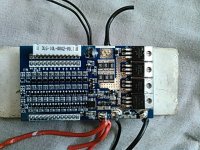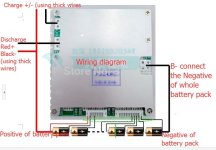Greetings,
I just snagged up this BMS from china and I want to get some input. There are 14 leads.
1st off - I got this because it was dirt cheap($20 shipped). So naturally, I'm suspicious of it. But, I'll give it a chance to prove itself (for fun).
Anybody used this or seen this? It seemed rather small to me, but the ratings state 30A continuous and 60A peak.
Thoughts?
http://www.aliexpress.com/snapshot/6667188929.html?orderId=67259245884784
actual product


image hosting no register
I just snagged up this BMS from china and I want to get some input. There are 14 leads.
1st off - I got this because it was dirt cheap($20 shipped). So naturally, I'm suspicious of it. But, I'll give it a chance to prove itself (for fun).
Anybody used this or seen this? It seemed rather small to me, but the ratings state 30A continuous and 60A peak.
Thoughts?
http://www.aliexpress.com/snapshot/6667188929.html?orderId=67259245884784
actual product


image hosting no register



